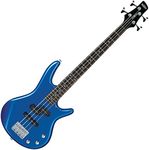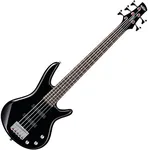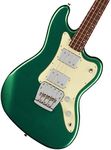Buying Guide for the Best Short Scale Bass
Choosing the right short-scale bass guitar can be a rewarding experience, especially if you know what to look for. Short-scale basses are known for their shorter necks and more compact size, making them ideal for players with smaller hands or those who prefer a lighter instrument. When selecting a short-scale bass, it's important to consider several key specifications to ensure you find the best fit for your playing style and needs. Here are the key specs to focus on and how to navigate them effectively.Scale LengthScale length refers to the distance from the bridge to the nut of the bass guitar. For short-scale basses, this typically ranges from 30 to 32 inches. This spec is important because it affects the tension of the strings and the overall feel of the instrument. A shorter scale length results in less string tension, making it easier to press down the strings and play. If you have smaller hands or prefer a more comfortable playing experience, a shorter scale length is ideal. However, if you are used to standard basses, you might need some time to adjust to the different feel.
Body MaterialThe body material of a bass guitar influences its tone and weight. Common materials include alder, ash, mahogany, and basswood. Alder and ash are known for their balanced tone and are often used in versatile basses. Mahogany provides a warmer, richer sound, while basswood is lighter and offers a more neutral tone. When choosing the body material, consider the type of music you play and the sound you want to achieve. If you play a variety of genres, a balanced tone from alder or ash might be best. For a warmer sound, mahogany is a good choice.
PickupsPickups are the components that capture the sound of the strings and convert it into an electrical signal. There are two main types: single-coil and humbucker. Single-coil pickups offer a bright, clear tone and are great for genres like funk and pop. Humbuckers provide a thicker, warmer sound and are preferred for rock and heavier music. Some basses come with a combination of both, offering more versatility. Think about the style of music you play most often and choose pickups that complement that sound.
Neck ProfileThe neck profile refers to the shape and thickness of the neck. Common profiles include C-shaped, U-shaped, and V-shaped. A C-shaped neck is rounded and comfortable for most players, making it a popular choice. U-shaped necks are thicker and provide a more substantial feel, which some players prefer for added stability. V-shaped necks have a more pronounced ridge and can be comfortable for players who use their thumb on the back of the neck. Your hand size and playing style will guide you in choosing the right neck profile. Try different profiles to see which feels most comfortable for you.
Fingerboard MaterialThe fingerboard material affects the feel and tone of the bass. Common materials include rosewood, maple, and ebony. Rosewood fingerboards offer a warm, smooth feel and a rich tone. Maple fingerboards provide a brighter sound and a snappier feel. Ebony fingerboards are known for their smoothness and articulate tone. Consider the type of sound and feel you prefer when choosing the fingerboard material. If you like a warmer tone, rosewood is a good choice. For a brighter sound, maple is ideal.
WeightThe weight of the bass guitar can impact your comfort, especially during long playing sessions. Short-scale basses are generally lighter than standard basses, but there can still be variations. Lighter basses are easier to handle and less tiring to play, making them a good choice for younger players or those with physical limitations. Heavier basses can provide a more solid feel and potentially better sustain. Consider how long you typically play and whether you need a lighter instrument for comfort.



















